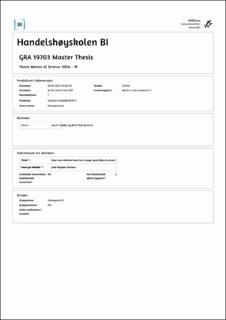| dc.contributor.author | Chalise, Sunil | |
| dc.contributor.author | Dahl, Rolf Martin | |
| dc.date.accessioned | 2023-11-08T09:56:29Z | |
| dc.date.available | 2023-11-08T09:56:29Z | |
| dc.date.issued | 2023 | |
| dc.identifier.uri | https://hdl.handle.net/11250/3101342 | |
| dc.description | Masteroppgave(MSc) in Master of Science in Business, Finance - Handelshøyskolen BI, 2023 | en_US |
| dc.description.abstract | This master thesis aims to explain how dividend taxation changes ownership structure in privately
held Norwegian firms. While previous studies have focused on changes in dividend policy,
our thesis looks at how changes in dividend taxation affect companies’ ownership structure.
We find that the proportion of privately held companies in Norway have shifted toward being
more single-owned after the tax reform in 2006. This shows evidence of a high increase
in ownership concentration after the tax reform was introduced in 2006. We also observe a
significant decrease in the average dividend payout ratio. The cost of reducing potential conflict
between minority and majority shareholders is higher with dividend taxation. We also found
that firms are less likely to raise paid-in capital from minority shareholders. The majority shareholders
may choose to have more concentrated ownership, reducing the firm’s ability to bring
in new equity in the long term.
Jointly, these facts suggest that newer companies avoid having minority shareholders to avert
dividends that became expensive after tax reform. We have fewer owners that are less diversified
and are risk-averse because of the lack of diversification. This could seriously affect the future
investment opportunities for privately held Norwegian firms.
II | en_US |
| dc.language.iso | eng | en_US |
| dc.publisher | Handelshøyskolen BI | en_US |
| dc.subject | finans | en_US |
| dc.subject | finance | en_US |
| dc.title | How does diuidend taxation change ownership structure? | en_US |
| dc.type | Master thesis | en_US |
